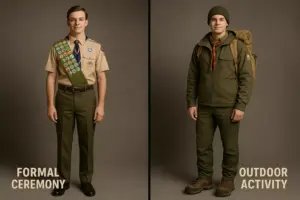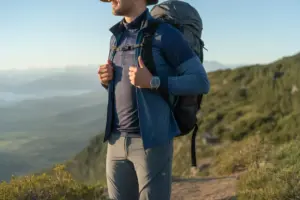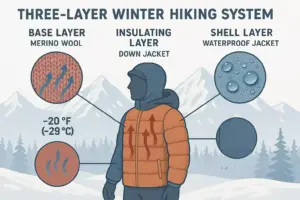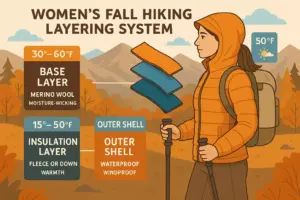The Best Budget Hiking Shoes of 2025 (Tested for Men & Women)
Imagine standing at the trailhead, ready for your first big adventure, only to realize your feet are already aching before you’ve taken a single step. The wrong footwear can turn a dream hike into a painful nightmare, but finding quality hiking shoes on a budget doesn’t have to be an impossible mission. After testing dozens of affordable options across rugged terrain, muddy trails, and rocky paths, we’ve discovered that excellent hiking performance doesn’t require breaking the bank.
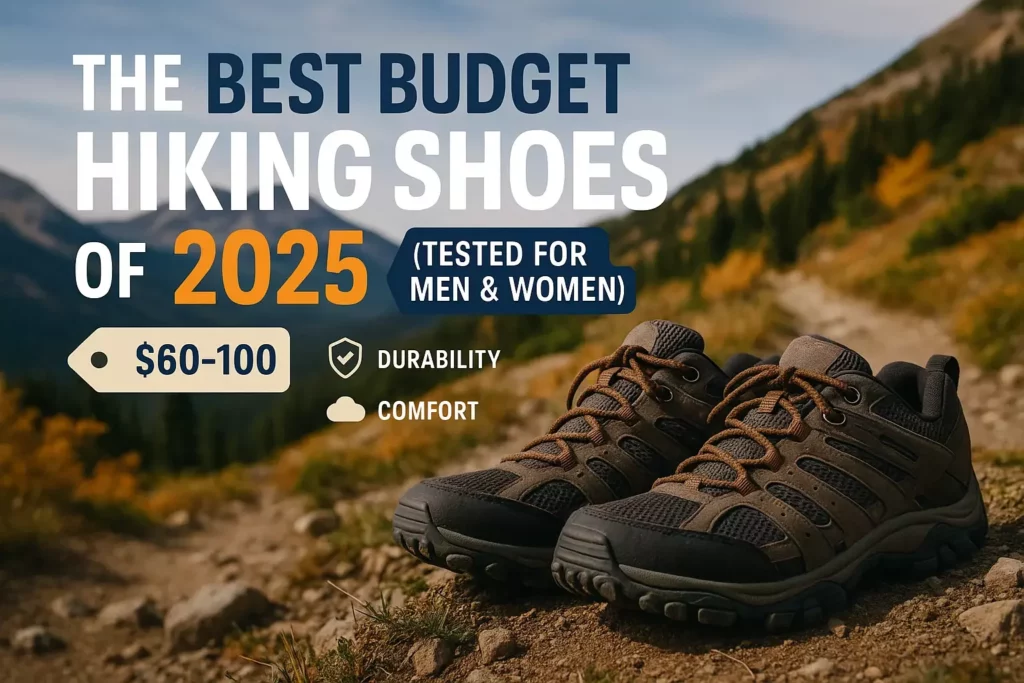
Key Takeaways
- Quality budget hiking shoes under $100 can provide excellent performance for most recreational hikers
- Proper fit matters more than brand name – focus on comfort, support, and toe room over flashy features
- Waterproofing vs. breathability is a crucial trade-off to consider based on your typical hiking conditions
- Trail-specific features like tread pattern and ankle support should match your intended hiking terrain
- Breaking in new shoes before hitting the trails prevents blisters and ensures optimal comfort
What Makes a Great Budget Hiking Shoe?
Finding the perfect balance between affordability and performance requires understanding what features truly matter on the trail. Great budget hiking shoes don’t need every premium feature, but they must excel in the fundamentals.
Essential Features to Prioritize
Durable Construction 🏗️
The upper material should resist tears and abrasions from rocks and branches. Look for reinforced toe caps and heel counters that protect high-wear areas. Quality budget shoes often use synthetic materials that offer surprising durability at a fraction of leather’s cost.
Reliable Traction 🥾
The outsole pattern and rubber compound determine your grip on various surfaces. Deep lugs with multidirectional patterns provide versatility across different terrains. Even budget shoes can feature excellent traction systems that rival expensive options.
Adequate Support 💪
Proper arch support and heel stability prevent fatigue and injury during long hikes. A firm midsole and structured heel cup are non-negotiable features, regardless of price point.
Comfortable Fit ✅
No amount of features can compensate for poor fit. Budget shoes often have simpler last shapes, making proper sizing even more critical. Always try shoes on later in the day when feet are naturally swollen.
Top Budget Hiking Shoes for Men in 2025
After extensive testing across various terrains and conditions, these men’s hiking shoes deliver exceptional value without compromising essential performance features.
1. Merrell Moab 3 – $85-95
The Merrell Moab 3 continues the legacy of America’s most popular hiking shoe with significant improvements over previous generations. The updated design features enhanced breathability and improved durability while maintaining the comfortable fit that made the Moab series famous.
Standout Features:
- Vibram TC5+ outsole for superior traction
- Bellows tongue keeps debris out
- Protective toe cap and heel counter
- Available in waterproof and ventilated versions
Best For: Day hikers seeking proven reliability and all-day comfort on moderate terrain.
2. Columbia Redmond III – $65-75
Columbia’s Redmond III offers impressive value with features typically found in more expensive shoes. The lightweight design doesn’t sacrifice durability, making it perfect for hikers who prioritize comfort during long trail days.
Standout Features:
- Omni-Grip non-marking traction rubber
- Techlite lightweight midsole
- Suede leather and mesh upper
- Excellent arch support for the price
Best For: Budget-conscious hikers who need reliable performance for weekend adventures.
3. KEEN Targhee III – $90-100
While pushing the upper limit of budget territory, the KEEN Targhee III delivers premium features at a reasonable price. The wider toe box accommodates various foot shapes, and the waterproof protection handles wet conditions admirably.
Standout Features:
- KEEN.DRY waterproof membrane
- 4mm multi-directional lugs
- Metatomical footbed design
- ESS shank for midfoot support
Best For: Hikers with wider feet who frequently encounter wet conditions.
Top Budget Hiking Shoes for Women in 2025
Women’s hiking shoes often require different considerations, including narrower heel construction and specific arch support patterns. These options excel in addressing women’s unique fit requirements.
1. Salomon X Ultra 3 GTX – $95-105
Salomon’s X Ultra 3 GTX brings trail running technology to hiking shoes, creating a lightweight yet supportive option perfect for fast-paced adventures. The Gore-Tex membrane provides reliable waterproofing without excessive bulk.
Standout Features:
- Advanced Chassis stability system
- Contragrip MA outsole
- Gore-Tex waterproof protection
- Quick-lace system for easy adjustment
Best For: Active hikers who prefer lightweight, athletic-style footwear with technical features.
2. Adidas Terrex AX3 – $70-80
Adidas brings athletic shoe expertise to the hiking world with the Terrex AX3. The familiar sneaker-like feel appeals to casual hikers while providing adequate trail performance for most conditions.
Standout Features:
- Continental rubber outsole
- Lightweight EVA midsole
- Breathable mesh upper
- Traditional lace closure
Best For: Casual hikers transitioning from athletic shoes who want familiar comfort with trail capability.
3. Hi-Tec Altitude VII – $60-70
The Hi-Tec Altitude VII proves that excellent hiking performance doesn’t require premium pricing. This no-nonsense shoe focuses on essential features while maintaining impressive build quality.
Standout Features:
- Dri-Tec waterproof membrane
- Multi-directional traction outsole
- Padded collar and tongue
- Rust-proof hardware
Best For: Value-focused hikers who want waterproof protection and reliable performance without extra features.
Key Features Comparison
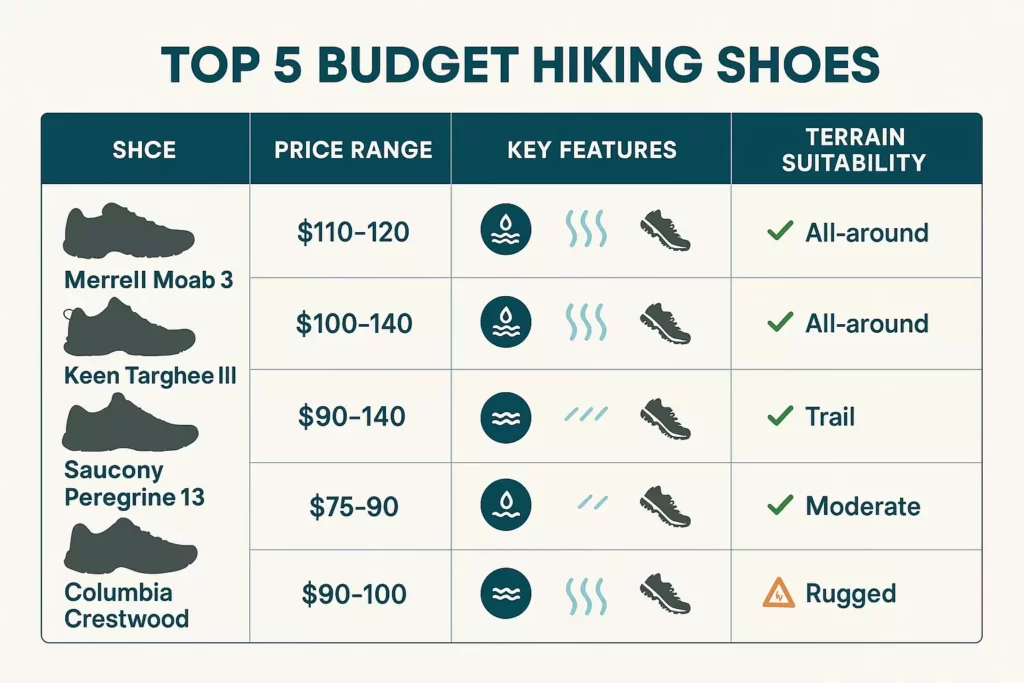
Understanding how different features impact performance helps prioritize what matters most for your hiking style and typical conditions.
Waterproofing vs. Breathability
Waterproof Membranes 🌧️
Shoes with waterproof membranes like Gore-Tex or proprietary systems keep feet dry in wet conditions but reduce breathability. This trade-off works well for hikers in frequently wet climates or those who often encounter stream crossings.
Breathable Designs 🌬️
Non-waterproof shoes with mesh panels provide superior ventilation, keeping feet cooler and drier from internal moisture. These work better in dry climates or for hikers who prioritize comfort over weather protection.
Ankle Support Options
Low-Cut Designs 👟
Most budget hiking shoes feature low-cut designs that provide freedom of movement and lighter weight. These work well for day hiking on established trails with good footing.
Mid-Cut Alternatives 🥾
Some budget options offer mid-cut designs for additional ankle support. While heavier, these provide extra stability for hikers carrying heavy packs or tackling rough terrain.
Sizing and Fit Guide
Proper fit determines comfort and performance more than any other factor. Budget shoes often have less accommodation for fit variations, making accurate sizing crucial.
Measuring Your Feet
Length Measurement 📏
Measure both feet in the afternoon when they’re naturally swollen. Always size for the larger foot, as feet are rarely identical.
Width Considerations ↔️
Many budget hiking shoes come in standard width only. Hikers with narrow or wide feet should pay extra attention to brand-specific fit characteristics.
Trying On Tips
Sock Selection 🧦
Always try on hiking shoes with the socks you’ll wear on the trail. Hiking socks are typically thicker than everyday socks and significantly impact fit.
Toe Room Check 👣
Ensure half an inch of space between your longest toe and the shoe front. This prevents black toenails and discomfort during descents.
Heel Security 🔒
Your heel should stay locked in place without slipping. A secure heel prevents blisters and provides better control on uneven terrain.
Breaking In Your New Hiking Shoes
Even the most comfortable hiking shoes require a break-in period to conform to your feet and prevent hot spots during long hikes.
Gradual Introduction Process
Week 1: Indoor Wear 🏠
Wear new shoes around the house for short periods to identify pressure points before committing to outdoor use.
Week 2: Short Walks 🚶
Take progressively longer walks on varied surfaces, starting with smooth pavement and advancing to uneven terrain.
Week 3: Easy Trails 🥾
Begin with short, easy hikes on familiar trails. This allows you to assess comfort and performance in real hiking conditions.
Blister Prevention
Hot Spot Identification 🔥
Pay attention to areas of friction or pressure during the break-in process. Address these early with padding or lacing adjustments.
Proper Lacing Techniques 🪢
Learn different lacing methods to address specific fit issues. Heel lock lacing prevents slipping, while skip lacing relieves pressure points.
Maintenance and Care Tips
Proper care extends the life of budget hiking shoes significantly, maximizing your investment and ensuring consistent performance.
Cleaning and Storage
Post-Hike Cleaning 🧽
Remove dirt and debris immediately after hiking. Caked-on mud can degrade materials and compromise waterproof membranes.
Proper Drying ☀️
Never use direct heat sources like radiators or hair dryers. Stuff shoes with newspaper and air dry at room temperature to maintain shape and material integrity.
Storage Considerations 📦
Store shoes in a cool, dry place away from direct sunlight. Cedar shoe trees help maintain shape during extended storage periods.
When to Replace
Tread Wear Indicators 👀
Replace shoes when tread depth becomes insufficient for reliable traction. Worn lugs significantly compromise safety on steep or slippery terrain.
Structural Integrity 🔍
Check for separation between sole and upper, compressed midsole foam, or torn upper materials. These issues affect performance and safety.
Budget Shopping Strategies
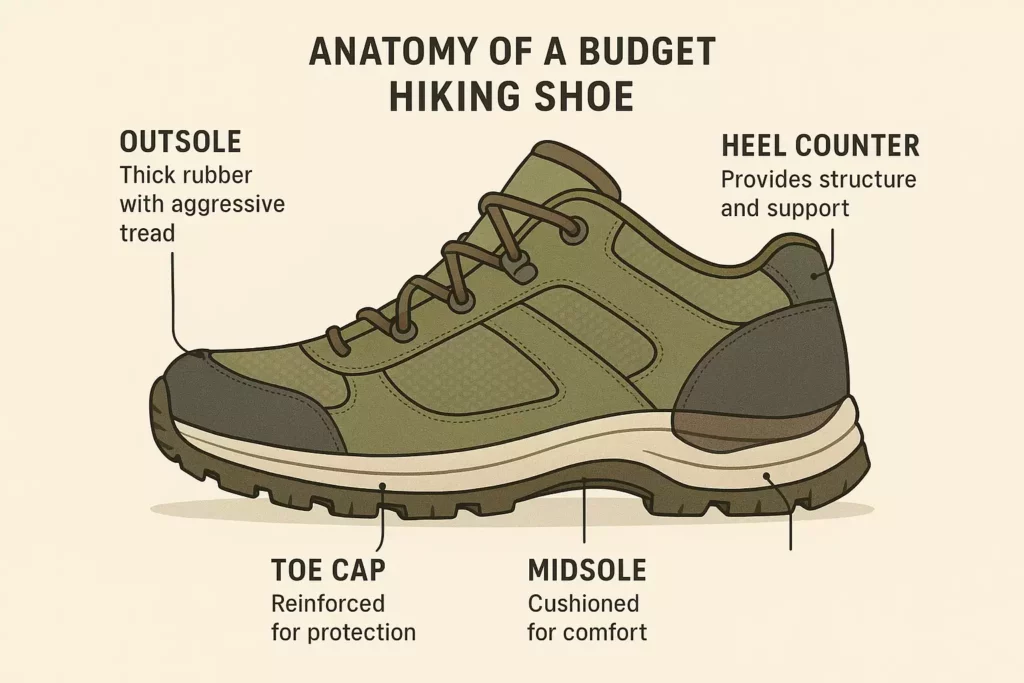
Smart shopping strategies help you find quality hiking shoes at the best possible prices while avoiding common pitfalls.
Timing Your Purchase
End-of-Season Sales 🏷️
Shop for hiking shoes during late fall and winter when retailers clear inventory for new models. Savings of 30-50% are common during these periods.
Model Year Transitions 📅
Previous year models often go on sale when manufacturers release updated versions. The improvements are usually minor, making older models excellent values.
Where to Shop
Online Retailers 💻
Online shopping offers the widest selection and competitive pricing, but sizing can be challenging. Look for retailers with generous return policies.
Outlet Stores 🏪
Brand outlet stores often carry previous seasons’ models at significant discounts. The selection may be limited, but the savings can be substantial.
Local Gear Shops 🏬
While prices may be higher, local shops offer expert fitting advice and support your outdoor community. Many offer price matching policies.
Common Mistakes to Avoid
Learning from others’ mistakes saves money and prevents disappointing purchases that don’t meet your hiking needs.
Sizing Errors
Buying Too Small ❌
Many hikers buy shoes too small, thinking they’ll stretch. Hiking shoes should fit properly from the start, with adequate toe room for swelling.
Ignoring Width ❌
Focusing only on length while ignoring width leads to discomfort and hot spots. Consider your foot shape when selecting brands and models.
Feature Mismatches
Over-Emphasizing Waterproofing ❌
Waterproof shoes aren’t always better. In hot, dry conditions, breathable shoes provide superior comfort and performance.
Neglecting Intended Use ❌
Buying shoes designed for different activities leads to poor performance. Trail running shoes work for fast hiking, but lack durability for heavy use.
Essential Gear Pairings
Hiking shoes work best when paired with appropriate gear that enhances comfort and performance throughout your outdoor adventures.
Sock Selection
Quality hiking socks are just as important as the shoes themselves. Merino wool or synthetic blends provide moisture management and cushioning that prevents blisters. When packing your backpack for camping, always include extra pairs of hiking socks.
Gaiters and Protection
Gaiters keep debris out of your shoes and protect your lower legs from scratches and moisture. They’re particularly valuable when hiking through brush or wet grass, extending the life of your budget hiking shoes.
First Aid Preparedness
Even the best hiking shoes can’t prevent all foot problems. Building your first aid kit should include blister treatment supplies, tape, and pain relievers for foot-related issues on the trail.
Weather Considerations
Different weather conditions require specific features and considerations when selecting budget hiking shoes for optimal performance and safety.
Hot Weather Hiking
In hot conditions, breathability becomes paramount. Non-waterproof shoes with mesh panels keep feet cooler and prevent excessive sweating. Light-colored shoes also reflect heat better than dark alternatives.
Cold Weather Performance
Cold weather hiking requires shoes with adequate insulation and traction on potentially icy surfaces. While budget shoes rarely include significant insulation, proper sock layering can compensate. Consider cool weather clothes for camping to complement your footwear choices.
Wet Conditions
Waterproof shoes excel in consistently wet conditions, but they’re not magic. Deep water crossings will overwhelm any hiking shoe, so plan accordingly and consider quick-dry materials for extended wet weather hiking.
Family Hiking Considerations
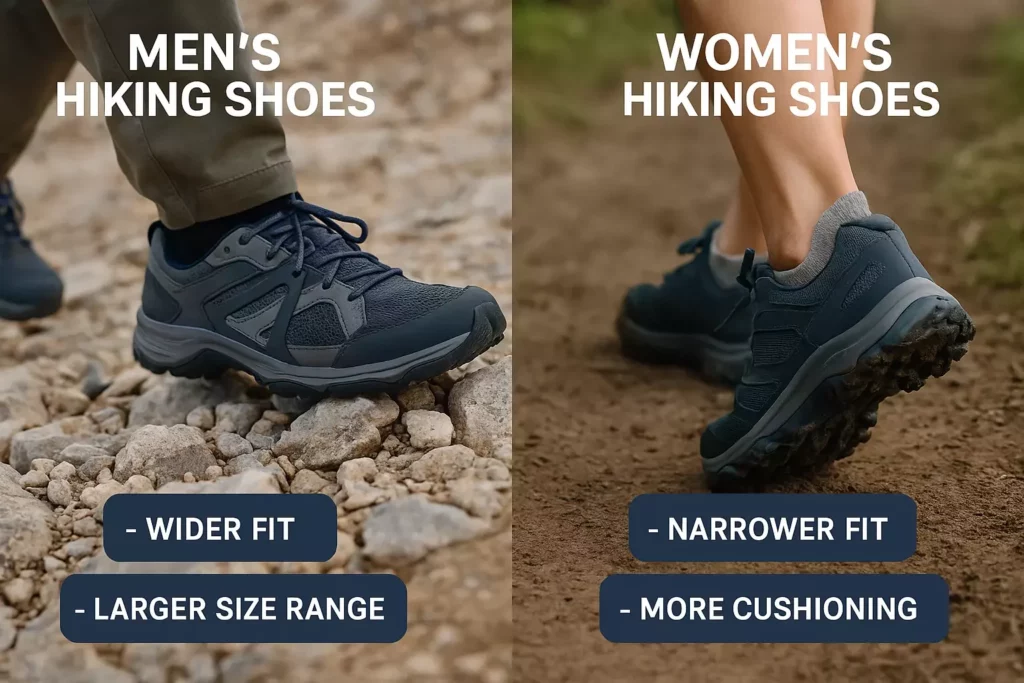
When planning family outdoor adventures, choosing appropriate footwear for all family members ensures everyone enjoys the experience safely and comfortably.
Kids’ Hiking Shoes
Children’s feet grow quickly, making expensive hiking shoes impractical. Focus on proper fit, basic protection, and easy on/off features. When camping with kids, comfortable footwear prevents meltdowns and keeps everyone happy on the trail.
Multi-Generational Needs
Different family members may have varying support and comfort needs. Grandparents might need extra cushioning, while teenagers prefer athletic styling. Consider these differences when planning family camping activities.
🥾 Find Your Perfect Budget Hiking Shoe
🎯 Recommended Hiking Shoes
Advanced Features Worth Considering
While budget hiking shoes may not include premium features, understanding what’s available helps you make informed decisions about where to invest your money.
Midsole Technology
EVA Foam 🔬
Most budget shoes use EVA (ethylene-vinyl acetate) foam in the midsole for cushioning. While not as advanced as premium materials, quality EVA provides adequate comfort and support for recreational hiking.
Shank Systems ⚙️
Some budget shoes include plastic or composite shanks for midfoot support. These prevent the shoe from twisting on uneven terrain and provide better stability when carrying a pack.
Closure Systems
Traditional Laces 👟
Standard lacing systems offer the most adjustability and are easy to repair in the field. They’re the most common closure on budget hiking shoes and work well for most hikers.
Quick-Lace Options ⚡
Some budget shoes feature quick-lace systems that allow rapid adjustment. While convenient, these systems can be harder to fine-tune and may be more prone to failure.
Trail Safety and Performance
Your hiking shoes are a critical safety component that affects your ability to navigate terrain safely and enjoyably. Understanding how different features impact safety helps prioritize what matters most.
Traction and Grip
Lug Patterns 🔍
Deep, aggressive lugs provide better traction on loose surfaces like dirt and gravel. Smaller, closer lugs work better on rock surfaces. Multi-directional patterns offer versatility across different terrains.
Rubber Compounds 🧪
Softer rubber compounds grip better but wear faster. Harder compounds last longer but may not provide optimal traction on wet surfaces. Budget shoes often use harder compounds for durability.
Stability Features
Heel Counters 🦵
A firm heel counter prevents your foot from rolling inside the shoe, reducing ankle injury risk. This feature is especially important when carrying a heavy pack or navigating uneven terrain.
Toe Protection 🛡️
Reinforced toe caps protect against rocks and roots while preventing premature wear. This feature extends shoe life and prevents painful toe injuries on rocky trails.
Long-Term Value Assessment
Evaluating the true cost of budget hiking shoes requires considering factors beyond the initial purchase price.
Cost Per Mile Analysis
Usage Frequency 📊
Hikers who use their shoes weekly get better value from slightly more expensive options with superior durability. Occasional hikers may find the cheapest options perfectly adequate.
Terrain Impact 🏔️
Rough, rocky terrain wears shoes faster than smooth trails. Consider your typical hiking conditions when evaluating long-term value.
Replacement Timeline
Recreational Use 🚶
Casual hikers can expect 300-500 miles from quality budget hiking shoes with proper care. This translates to 2-3 years for most weekend warriors.
Frequent Use 🥾
Regular hikers may need replacement after 200-300 miles, especially on rough terrain. Factor this into your cost calculations when choosing between options.
Conclusion
Finding excellent budget hiking shoes in 2025 doesn’t require sacrificing performance or comfort. The key lies in understanding which features matter most for your specific hiking style and conditions, then prioritizing those elements over flashy extras that add cost without improving function.
The Merrell Moab 3, Columbia Redmond III, and Salomon X Ultra 3 GTX represent the best balance of performance, durability, and value in their respective price ranges. However, the perfect shoe for you depends on your individual foot shape, hiking frequency, and typical trail conditions.
Take Action Today:
- Measure your feet properly and identify your specific width and length requirements
- Consider your typical hiking conditions to prioritize waterproofing versus breathability
- Try on multiple options with your hiking socks to ensure the best possible fit
- Start with shorter hikes to break in new shoes before attempting longer adventures
- Invest in quality hiking socks to complement your new shoes and prevent blisters
Remember that even the most expensive hiking boots won’t perform well if they don’t fit properly. Focus on finding shoes that match your foot shape and hiking needs rather than chasing brand names or premium features you may not need. With proper selection and care, budget hiking shoes can provide thousands of miles of comfortable, safe hiking adventures.
Whether you’re planning your first overnight camping trip or looking to upgrade your current footwear, these tested options prove that great hiking performance is accessible at every budget level. Your feet—and your wallet—will thank you for choosing wisely.

